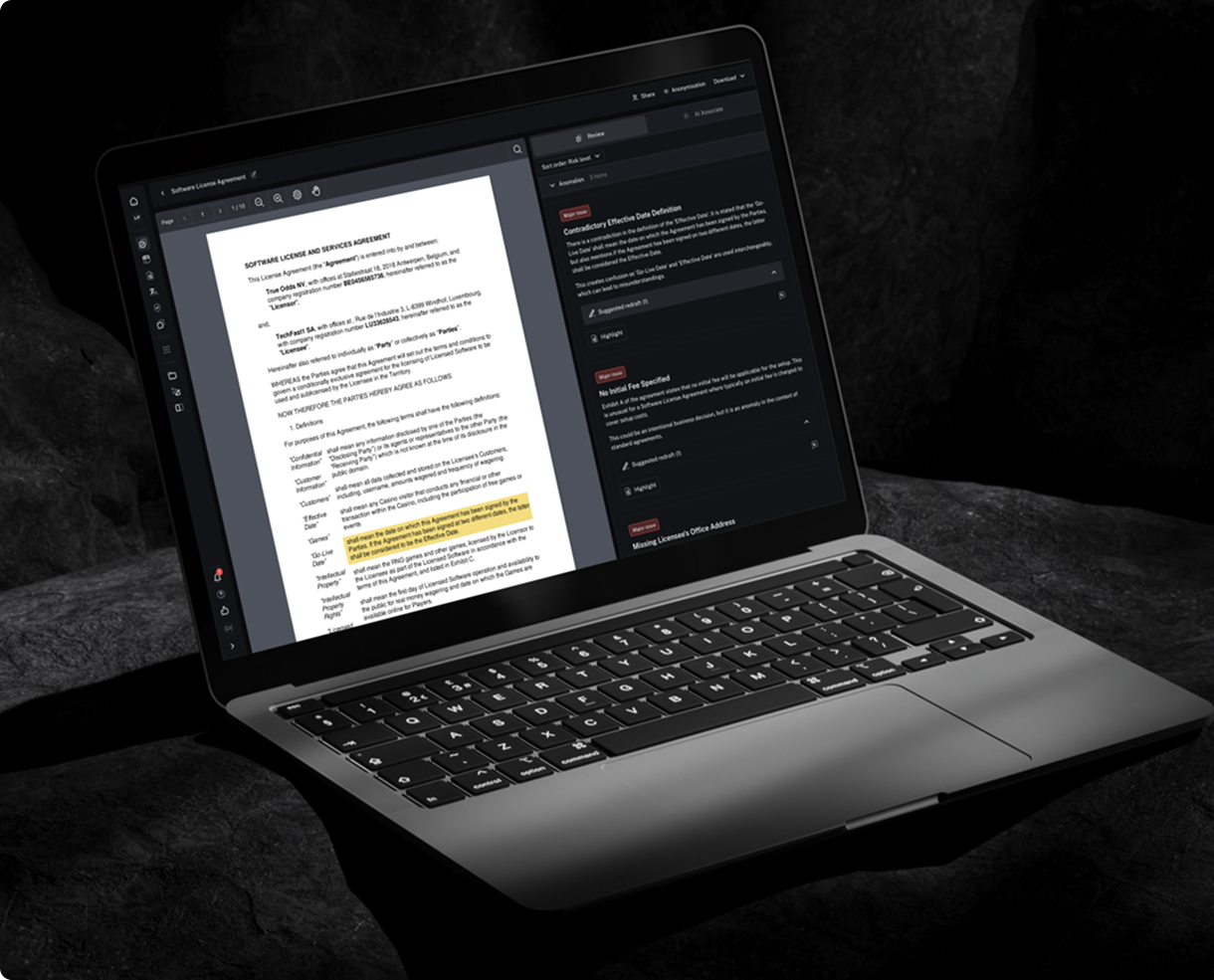The contract review process explained

Contract review is a cornerstone of risk management and operational efficiency for organisations that handle large volumes of agreements. For in-house legal teams, contract managers, procurement professionals, and business leaders, mastering the contract review process is essential. Effective contract review not only ensures compliance but also accelerates business, protects organizational interests, and supports growth. This guide breaks down the contract review process into actionable steps, highlights common pitfalls, and offers expert strategies to help your team transform contract review from a bottleneck into a business enabler.
Understanding the contract review process
Contract review is a structured, multi-stage process in which legal and business teams analyse agreements to identify risks, ensure compliance, and protect organizational interests. Rather than being a single event, it functions as a lifecycle that spans from initial intake to final approval.
Why contract review is critical for risk management
Effective contract review helps organisations identify legal, financial, and operational risks before they escalate into costly disputes. It ensures compliance with regulatory standards, safeguarding against fines and reputational harm. Beyond compliance, it reduces errors and delays, particularly in teams with limited legal resources.
Learn more: Can AI review legal contracts? Everything you need to know
Key stakeholders in the review process
Successful contract review depends on collaboration between legal and business teams. Legal team members such as General Counsel, Legal Operations Managers, and Compliance Officers typically lead the process, while non-legal teams like procurement, sales, finance, and insurance provide crucial context. Senior leaders, including the General Counsel or CEO often oversee strategic agreements. External counsel may be brought in for complex or high-risk contracts that require specialist input.
Common types of contracts reviewed
Contract review applies to a wide range of agreements, including non-disclosure agreements (NDAs), procurement and vendor contracts, sales and service agreements, and finance or insurance-related documents. Each type carries unique risks and requirements, but all benefit from a structured, consistent review process that aligns legal protection with business goals.
Outcomes of a successful contract review
An effective contract review process delivers tangible business value. It shortens deal cycles, accelerates revenue recognition, and ensures compliance with legal and regulatory obligations. Organisations gain operational efficiency, reduce reliance on external counsel, and strengthen their ability to scale. Most importantly, a disciplined review process empowers teams to negotiate confidently and maintain a competitive advantage.
Key stages of the contract review process
A well-structured contract review process follows a clear sequence of stages, each with defined objectives and best practices that guide teams from initial intake through final approval.
1. Initial contract intake and document gathering
The process begins with collecting all relevant documents and background information needed for context. Teams confirm the contract type, the parties involved, and the business purpose behind the agreement. Establishing clear ownership at this stage ensures accountability and prevents delays later in the review cycle.
2. Preliminary review and issue spotting
Once gathered, the contract undergoes an initial assessment to identify missing information, incomplete sections, or obvious red flags. Reviewers highlight key business terms, note any non-standard clauses, and flag agreements that require additional scrutiny or specialist input. This early stage also helps teams to triage the request by understanding the urgency and complexity of the review.
3. Detailed clause-by-clause analysis
During this stage, each clause is examined for its legal, financial, and operational implications. Reviewers compare terms against internal playbooks, corporate policies, and compliance standards. Standardised templates and AI-assisted tools can accelerate this process by identifying deviations, ensuring consistency, and minimising human error.
4. Risk assessment and mitigation planning
After identifying potential issues, teams evaluate the likelihood and impact of each risk. Where necessary, they propose alternative language or negotiation strategies to mitigate exposure. All findings and recommendations should be documented to maintain a clear record of how decisions were made and risks addressed.
5. Internal collaboration and stakeholder feedback
Contract review is rarely a solo task. Drafts are shared with business, legal, and compliance stakeholders for input and alignment. Teams collaborate to resolve conflicting feedback, track changes, and maintain version control throughout the process. Transparent communication during this stage prevents misunderstandings and ensures final approval moves smoothly.
6. Final approval and sign-off
The final stage involves obtaining formal approval from authorized signatories. Reviewers confirm that all changes are accurately incorporated and documented before execution. Once signed, the final version is archived, and relevant data is updated in the organization’s contract management system to maintain an accurate, accessible record.
Building an effective contract review checklist
A clear, structured checklist helps teams review contracts consistently and catch issues before they become risks. It ensures no key detail is missed and allows reviewers to work faster and with greater confidence.
Essential items to include
Every checklist should verify core elements of a contract: the parties involved, contract scope, and term. Reviewers must confirm payment and financial terms, check confidentiality and data protection clauses, and review termination, renewal, and amendment provisions. Dispute resolution mechanisms and compliance with relevant laws should also be confirmed before approval.
Legal, financial, and operational considerations
Each agreement should be tested against practical questions. Are the right parties authorised to sign? Do payment terms align with business expectations? Are liability and indemnity clauses fair? Does data handling meet privacy obligations such as GDPR or CCPA? Are deliverables and timelines clear and achievable? These checks reduce uncertainty and prevent costly disputes.
Common red flags and deal-breakers
Reviewers should pay close attention to ambiguous language, one-sided termination rights, and disproportionate penalties. Missing dispute resolution clauses or non-compliance with mandatory regulations are also major warning signs. Identifying these issues early protects the organization from unnecessary risk.
Tailoring checklists for different contract types
Checklists should reflect the type of agreement being reviewed. NDAs require focus on confidentiality scope and duration. Procurement contracts need detailed attention to warranties, delivery terms, and service levels. Sales contracts should emphasise payment schedules, delivery timelines, and acceptance criteria. Customising by contract type makes review faster and more accurate.

Common pitfalls and how to avoid them
Even the most experienced legal teams can fall into patterns that slow contract review or introduce unnecessary risk. One of the most frequent problems is ambiguous language, where clauses appear clear until tested in practice. Using standardised templates and AI-driven clause flagging helps identify vague terms early and prevents confusion later.
Missed deadlines and renewal dates are another common pitfall. When contracts are scattered across email threads or spreadsheets, it becomes easy to lose track of key milestones. Automated alerts and centralised tracking systems keep obligations visible and ensure renewals happen on time.
Limited stakeholder involvement can also create bottlenecks. Contracts often affect finance, operations, and compliance teams, yet reviews may remain confined to the legal department. Collaborative tools that allow simultaneous commenting and editing in familiar platforms such as Microsoft Word or Teams help bridge this gap and keep everyone aligned.
Compliance oversights are equally costly. As regulations evolve, missing a required clause or retention rule can lead to fines or reputational harm. Automating compliance checks against current playbooks ensures every agreement meets the latest legal and industry standards.
Poor version control is another recurring issue. Multiple drafts, conflicting edits, and unclear approvals lead to confusion and unnecessary risk. Maintaining a single source of truth with automatic versioning and audit trails keeps the process transparent, defensible, and efficient.
Addressing these pitfalls early allows legal teams to build faster, more reliable review workflows that protect the business and strengthen collaboration across departments.
Best practices for streamlining the review process
Efficiency separates a legal team that supports business growth from one that slows it down. The most effective organisations use a combination of technology, clear processes, and ongoing training to turn contract review into a strategic advantage.
The first step is to work within familiar tools. Integrating review technology directly into Microsoft Word allows legal and business teams to collaborate in real time. Software such as LEGALFLY uses artificial intelligence to flag risky clauses, check compliance, and suggest alternative language so reviews move faster and stay consistent.
Standardisation also matters. A central library of approved templates and clauses reduces drafting time and ensures that every agreement aligns with the company’s risk and compliance standards.
Approvals should follow a defined workflow that matches the organisation’s structure. Automated routing based on contract type, value, or risk level keeps reviews efficient while maintaining the right level of oversight. Intelligent playbooks can also apply internal policies and regulatory requirements automatically. See examples in The 10 Best Legal Workflow Automation Tools for 2025
Training remains essential even with automation in place. Teams that understand contract structure and key risks can manage more reviews internally and give non-legal staff confidence to handle routine matters.
Automation should enhance human judgment, not replace it. Platforms like LEGALFLY can analyse large volumes of contracts quickly, highlight potential issues, and give legal teams more time to focus on complex negotiations and strategic decision-making.
Streamlined contract review is not just about speed. It enables more consistent, informed decisions that balance legal protection with business priorities.
Try AI contract review with LEGALFLY
Speak to a LEGALFLY expert to see how you can use AI for contract review today.

When to involve legal counsel or external experts
Automation and AI can manage routine contract reviews, but some situations still require specialist expertise. Engaging legal counsel or external advisors is most valuable in the following cases:
- High-value or high-risk contracts
Strategic partnerships, major transactions, or agreements with significant financial exposure. - Cross-border or complex arrangements
Contracts that span multiple jurisdictions, involve translation, or raise regulatory differences. - Regulatory or compliance-heavy agreements
Matters subject to strict oversight or industry-specific laws such as finance, healthcare, or government contracts. - Dispute-prone or sensitive negotiations
Situations with a history of conflict, unclear liability, or contentious terms that may lead to litigation. - Cost-benefit considerations
Evaluate the cost of external review against potential risk and complexity. Use internal teams and AI-assisted tools for routine contracts, and escalate to experts when stakes or uncertainty are high.
Learn more about how and where to use AI for legal documents
Next steps: improving your organisation’s contract review process
Continuous improvement keeps a contract management function efficient, compliant, and aligned with business goals. The most effective teams regularly evaluate how contracts are reviewed, approved, and tracked to identify new opportunities for optimization.
- Audit your current process
Map each stage of the workflow, identify bottlenecks, and collect feedback from users to understand where delays or risks occur. - Set clear performance indicators
Track metrics such as cycle time, error rates, and stakeholder satisfaction. Measuring progress helps demonstrate value to the business and ensures that efficiency gains are sustained. - Keep systems and templates current
Update templates, playbooks, and checklists regularly to reflect evolving regulations and business needs. Technology platforms like LEGALFLY make it easy to maintain version control and ensure everyone works from the most recent approved content. - Invest in training and collaboration
Equip legal and business teams with ongoing training on both contract literacy and technology tools. A shared understanding of risk and process consistency helps maintain quality and speed as the team grows. - Benchmark and adapt
Stay informed about changes in legal standards and industry best practices. Compare your process against peer organisations to identify new opportunities for automation, integration, or compliance improvements.
A well-managed contract review process never stops evolving. Continuous evaluation, supported by smart technology, helps organizations stay compliant, efficient, and ready for change.
Conclusion
Effective contract management is no longer optional for modern organisations. Streamlined review processes, intelligent automation, and consistent collaboration are what separate reactive teams from strategic business partners.
By adopting the right tools and practices, legal and business teams can work faster, reduce risk, and make smarter decisions with every agreement.
LEGALFLY helps organisations achieve this by combining AI-driven contract review, secure collaboration, and actionable insights in one platform. To see how your team can simplify and strengthen its contract management, book a demo with LEGALFLY today.